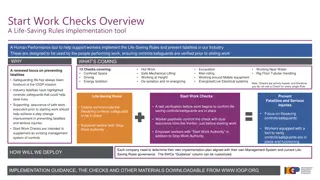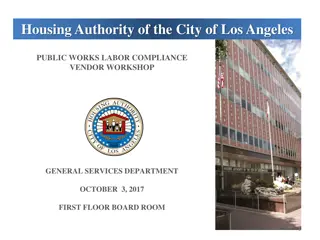Utilizing.Contractors and Other Gig Workers
Gig workers, also known as independent contractors, play a significant role in today's workforce by offering flexibility and specialized skills. This guide covers the definition of gig workers, types of gig workers, when to use them, proper classification, and the implications of misclassification. It emphasizes the importance of distinguishing between employees and contractors and provides insights into leveraging gig workers effectively.
Download Presentation

Please find below an Image/Link to download the presentation.
The content on the website is provided AS IS for your information and personal use only. It may not be sold, licensed, or shared on other websites without obtaining consent from the author. Download presentation by click this link. If you encounter any issues during the download, it is possible that the publisher has removed the file from their server.
E N D
Presentation Transcript
Utilizing Contractors and Other Gig Workers
Utilizing Contractors and Other Gig Workers WELCOME! 2
Agenda Definition of gig workers Types of gig workers When to use gig workers Proper classification Ramifications of misclassification 3
Definition of Gig Workers Gig workers, traditionally referred to as independent contractors, typically do short-term work for multiple clients. The work may be project-based, hourly or part-time, and can either be an ongoing contract or a temporary position. An independent contractor is a self-employed individual who is not economically dependent on one business or client and is not subject to a business s control regarding the method and means in which services are performed. Independent contractors are not covered by employment, labor and related tax laws. 4
Types of Gig Workers Gig workers are often individuals who are searching for full-time work and need to earn money while they job-hunt or individuals who simply don't want or need full- time employment and prefer the flexibility gig work provides. Source: Shiftgig, Profile of a Gig Worker 5
When to Use Gig Workers Some common situations when gig workers may be appropriate include: Projects of short or specific duration. Where specialized knowledge or experience is needed for a specific complex project. Exigent circumstances such as meeting needs when an employee goes on an extended leave of absence. [Insert details specific to your organization or industry regarding the use of gig workers.] 7
Proper Classification Gig workers who are not employees are generally referred to as independent contractors for the purposes of employment laws and taxes. Understanding the difference between a company employee and an independent contractor is critical. No legal test applies in every situation when deciding to classify a worker as an independent contractor. For example, the IRS and DOL use different, although similar, analytical frameworks. State laws may also differ. 8
Proper Classification (Department of Labor) Under the DOL rules, the following factors have been considered significant in determining independent contractor classification: The extent to which the services rendered are an integral part of the principal's business. The permanency of the relationship. The amount of the alleged contractor's investment in facilities and equipment. The nature and degree of control by the principal. The alleged contractor's opportunities for profit and loss. The amount of initiative, judgment, or foresight in open market competition with others required for the success of the claimed independent contractor. The degree of independent business organization and operation. 10
Proper Classification (Internal Revenue Service) The IRS looks at 11 factors within the following three areas when determining independent contractor status: Behavioral: Does the company control or have the right to control what the worker does and how the worker does his or her job? Financial: Are the business aspects of the worker's job controlled by the payer? (These include such considerations as how the worker is paid, whether expenses are reimbursed, who provides tools/supplies, etc.) Type of Relationship: Are there written contracts or employee-type benefits (e.g., pension plan, insurance, vacation pay, etc.)? Will the relationship continue, and is the work performed a key aspect of the business? 11
Proper Classification (State Laws) Workers' compensation laws. The test for independent contractor status under workers' compensation laws varies from state to state. [Insert details of your state WC law(s) regarding independent contractor status] State laws. Some states may have different or more-restrictive independent contractor classification rules. [Insert details of your state independent contractor classification law] 12
Ramifications of Misclassification Classifying a gig worker as an independent contractor should always be an informed and bona fide business decision. Misclassification of an individual as an independent contractor can give rise to a variety of liabilities. 13
Ramifications of Misclassification (cont.) Tax consequences. If an employer fails to withhold income taxes on behalf of a worker improperly classified as an independent contractor, the employer may be liable for federal or state taxes that were required to be withheld but were not. Wage and hour liability. Misclassified workers can bring claims for unpaid overtime or minimum wage violations under the Fair Labor Standards Act (FLSA) or state wage and hour laws. Employee benefits liability. Failure to offer benefits to an individual who should have been classified as an employee can result in penalties under the Affordable Care Act and ERISA. State insurance agencies and departments of labor will also be seeking back payments on unemployment insurance and workers comp premiums. 14
Summary An independent contractor/gig worker is a self-employed individual who is not subject to the employer s control regarding the method and means in which the service is performed. No legal test applies in every situation when deciding to classify a worker as an independent contractor. To minimize legal risk, employers should ensure that classification as an independent contractor would satisfy every test that may be applicable where the organization does business. 16
Training Evaluation Please complete the training evaluation sheet included in the handouts. Thank you for your interest and attention! 18

















































